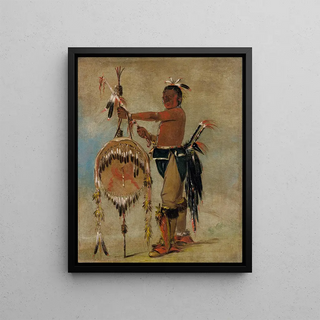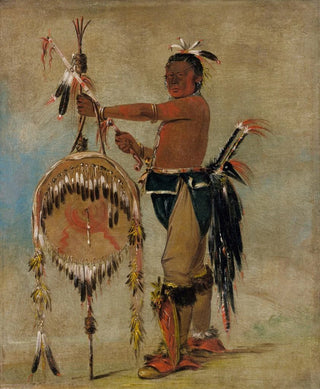Art print | Pash-ee-pa-h Little Chef Stabbing an Elderly Sauk Chief - George Catlin


View from behind

Frame (optional)
In the vibrant world of American art, few works manage to capture the very essence of the struggles and triumphs of indigenous peoples like "Pash-ee-pa-h Petit Chef Poignardant un Vénérable Chef Sauk" by George Catlin. This piece, both striking and evocative, immerses us in a historic moment where visual storytelling transcends mere depiction to become a window into a bygone era. Catlin, as a true narrator, uses his palette and brush to immortalize iconic figures and scenes laden with meaning, paying homage to Native American culture. The art print of this work allows us to appreciate the richness of this history while adding a touch of authenticity to our living spaces.
Style and uniqueness of the artwork
George Catlin's style stands out for its ability to blend realism and romanticism, creating portraits that are both faithful and imbued with a certain poetry. In "Pash-ee-pa-h Petit Chef Poignardant un Vénérable Chef Sauk," every detail is carefully considered, from the expressions of the characters to their traditional clothing, including the natural setting that surrounds them. This piece does not merely depict a scene of conflict; it also evokes the values and beliefs of indigenous peoples, highlighting their relationship with nature and spirituality. The palpable tension between the figures, along with the use of vivid colors, enhances the intensity of the frozen moment in time. Catlin's work is thus a poignant testimony of a culture on the brink of disappearance—a silent cry resonating through the ages.
The artist and his influence
George Catlin, a 19th-century artist and ethnographer, is often regarded as one of the first to document Native American life with such depth and sensitivity. Traveling across the United States, he dedicated his life to capturing the diversity and richness of indigenous cultures, going beyond the stereotypes often propagated by his contemporaries. His work not only helped preserve images

Matte finish

View from behind

Frame (optional)
In the vibrant world of American art, few works manage to capture the very essence of the struggles and triumphs of indigenous peoples like "Pash-ee-pa-h Petit Chef Poignardant un Vénérable Chef Sauk" by George Catlin. This piece, both striking and evocative, immerses us in a historic moment where visual storytelling transcends mere depiction to become a window into a bygone era. Catlin, as a true narrator, uses his palette and brush to immortalize iconic figures and scenes laden with meaning, paying homage to Native American culture. The art print of this work allows us to appreciate the richness of this history while adding a touch of authenticity to our living spaces.
Style and uniqueness of the artwork
George Catlin's style stands out for its ability to blend realism and romanticism, creating portraits that are both faithful and imbued with a certain poetry. In "Pash-ee-pa-h Petit Chef Poignardant un Vénérable Chef Sauk," every detail is carefully considered, from the expressions of the characters to their traditional clothing, including the natural setting that surrounds them. This piece does not merely depict a scene of conflict; it also evokes the values and beliefs of indigenous peoples, highlighting their relationship with nature and spirituality. The palpable tension between the figures, along with the use of vivid colors, enhances the intensity of the frozen moment in time. Catlin's work is thus a poignant testimony of a culture on the brink of disappearance—a silent cry resonating through the ages.
The artist and his influence
George Catlin, a 19th-century artist and ethnographer, is often regarded as one of the first to document Native American life with such depth and sensitivity. Traveling across the United States, he dedicated his life to capturing the diversity and richness of indigenous cultures, going beyond the stereotypes often propagated by his contemporaries. His work not only helped preserve images






